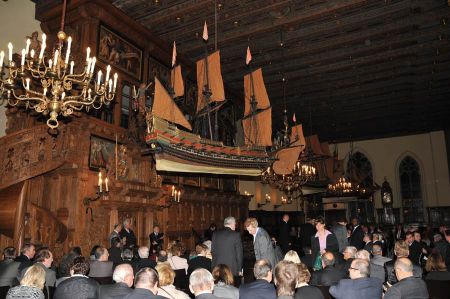90 years - Turkish national holiday in Bremen City Hall
- Written by Portal Editor
The strong connections between Turks and Germans, at least as far as interpersonal relationships are concerned, were once again very present on the occasion of the 90th anniversary of the Turkish Republic, which took place in Bremen as part of a ceremony in the ballroom of the town hall.
For years there has been close cooperation between the Turkish associations and organizations and the city administration of the Hanseatic City of Bremen, which was appropriately acknowledged during the various greetings. Last but not least, reference should once again be made at this point to the town twinning between Bremen and Izmir, which culminated this year with the visit of Bremen's Lord Mayor Jens Böhrnsen during the German-Turkish Friendship Festival in Izmir.
Mayor of the Free Hanseatic City of Bremen Karoline Linnert

33 imperial medallions, from Karl to Sigismund, but painted over in 1857, adorn the richly ornamented ceiling and thus propagate the status of a city directly subject to the empire. Models of orlog ships (warships that accompanied merchant convoys) from the years 1545, 1650, 1770 and 1779 hang from the ceiling. The miniature cannons of some ships were even used to fire cannon salutes at festivals. The chandelier with the double eagle was a gift from the Schütting in 1869. The furnishings and history of the upper hall alone are enough for an extensive visit, which we will certainly do again later.

A greeting followed from Mehmet Günay, Consul General of the Republic of Turkey, who, in addition to emphasizing the positive cooperation, also gave a short presentation on figures and data on the founding of the Republic. Between the lectures, Grup Pamukkale provided the musical framework for the event. In her concluding speech, the Honorary Consul of the Republic of Turkey, Yasemin Vierkötter, went into further goals of the cooperation before the applauding audience left the historic Upper Hall to enjoy Turkish-German conversation at the buffet.
On the history of the Republic of Türkiye
This was preceded by the actual collapse of the Ottoman Empire in World War I, the Turkish War of Independence and the deposition of Sultan Mehmed VI. His successor Abdülmecid II only bore the title of caliph.
With his deposition on March 3, 1924, the Ottoman dynasty was finally disempowered.
In 1925, a hat reform banned the fez (traditional Turkish men's headgear). Later the veil was banned for women and coeducation was introduced. In the same year, both the Islamic calendar and the Rumi calendar used at the same time were abolished and replaced by the Gregorian calendar. The metric system was also introduced.
Atatürk's actions were based on the ideology of Kemalism, which is based on six principles: Turkish nationalism, secularism, republicanism, statism, revolutionism and populism.
The reforms were not accepted without resistance by traditionalist forces. On February 13, 1925, the Kurdish minority under Sheikh Said revolted. It was a mixture of Kurdish nationalism and clerical opposition to Turkey's secularization. Like other uprisings, the uprising was violently suppressed by the military.
After Atatürk's death in 1938, his companion İsmet İnönü became President. Inönü endeavoured to continue the modernization of Turkey and to maintain foreign policy neutrality. He achieved the last territorial change through diplomatic channels: Hatay (Sanjak Alexandrette), a French mandate area since 1920, became an independent republic in 1938 and a Turkish province in 1939 (capital: İskenderun).
An example of German-Turkish friendship: Honour for Angela Merkel
"We stand for a harmonious and peaceful coexistence of peoples in our society," said Cihan Sendan, national chairman of the association.
With the award, the DTF wants to show respect to Merkel and her office, according to Sendan.
Please read as well:
